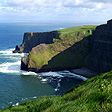BATTLE
OF THE BOYNE PARK & VISITORS CENTER
Battlefield of Irish Destiny
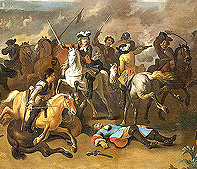 The Battle
of the Boyne was fought on the plains of the River Boyne valley near
Drogheda
in 1690. Protestant William of Orange (from Holland)
had deposed the Catholic King James II for the throne of England, Scotland
and Ireland. James had raised an army of 25,000 “Jacobites” including
6,000 French soldiers sent by King Louis XIVwith the intent to retake
the throne by beginning in Ireland where the Catholic predomination
would give his strongest advantage. He was met by the army of King
William with 36,000 troops of English, Scottish, French Hugenots, Dutch
and “Scots-Irish” protesants from Ulster (the north of
Ireland) who called themselves the "Inniskillingers" (see Inniskillen
Castle) – the “Williamites”. It was
the largest force of troops on Irish soil. Both kings were in personal
command of their armies facing across the river ford, James from the
south and William from the north..
The Battle
of the Boyne was fought on the plains of the River Boyne valley near
Drogheda
in 1690. Protestant William of Orange (from Holland)
had deposed the Catholic King James II for the throne of England, Scotland
and Ireland. James had raised an army of 25,000 “Jacobites” including
6,000 French soldiers sent by King Louis XIVwith the intent to retake
the throne by beginning in Ireland where the Catholic predomination
would give his strongest advantage. He was met by the army of King
William with 36,000 troops of English, Scottish, French Hugenots, Dutch
and “Scots-Irish” protesants from Ulster (the north of
Ireland) who called themselves the "Inniskillingers" (see Inniskillen
Castle) – the “Williamites”. It was
the largest force of troops on Irish soil. Both kings were in personal
command of their armies facing across the river ford, James from the
south and William from the north..
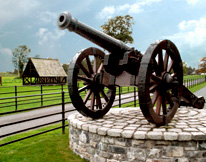 All
the fighting of the battle took place on the south side of the river
as James attempted to maximize his lesser forces in a pincer
movement against the Williamites. The plan failed and when William
crossed the river Drybridge with 3,500 horse cavalry he had held
in reserve.
The Jacobites were driven back and retreated as far as the River Shannon
to regroup, but never mounted another significant attack. With the
number of troops involved in the battle only about 1,500 were killed,
but the decisiveness of the outcome set protestant rule of Ireland
for the next two and a half centuries. The Battle of the Boyne is celebrated
on the 12th of July, but due to a change in calendars in the 1700's
was fought at the time on the 1st of July.
All
the fighting of the battle took place on the south side of the river
as James attempted to maximize his lesser forces in a pincer
movement against the Williamites. The plan failed and when William
crossed the river Drybridge with 3,500 horse cavalry he had held
in reserve.
The Jacobites were driven back and retreated as far as the River Shannon
to regroup, but never mounted another significant attack. With the
number of troops involved in the battle only about 1,500 were killed,
but the decisiveness of the outcome set protestant rule of Ireland
for the next two and a half centuries. The Battle of the Boyne is celebrated
on the 12th of July, but due to a change in calendars in the 1700's
was fought at the time on the 1st of July.
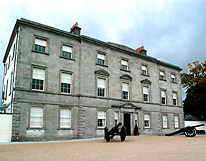 The Battle of Boyne battlefield site on the River Boyne about 40 minutes
from Dublin remains to commemorate one of the most significant battles
of English and Irish history. The site is mainly an undistrurbed park
of mown grass where the battle was fought, with marked walking trails
through the fields and woods to follow the significant troop movements
around the decisive battle. A vistor center is comprised of the Oldbridge
House, built fifty years after the battle in the 1740s by the Coddington
family who acquired the lands for their estate, a stone stable yard
and coach house. An audio-visual show explains the battle, its causes
and results. There is 17th Century artillery and weaponry on display,
some of it original, but much of it replica, a Tea Pavillion and garden
terrace. During the summer months on weekends and holidays, Living
History performances are offered with uniformed re-enactors demonstrating
historical military skills, 17the Century black powder musketry, artillery
and cavalry maneuvers, 15th Century armored knights and archery, and
18th Century Napoleonic Cavalry and dragoons.
The Battle of Boyne battlefield site on the River Boyne about 40 minutes
from Dublin remains to commemorate one of the most significant battles
of English and Irish history. The site is mainly an undistrurbed park
of mown grass where the battle was fought, with marked walking trails
through the fields and woods to follow the significant troop movements
around the decisive battle. A vistor center is comprised of the Oldbridge
House, built fifty years after the battle in the 1740s by the Coddington
family who acquired the lands for their estate, a stone stable yard
and coach house. An audio-visual show explains the battle, its causes
and results. There is 17th Century artillery and weaponry on display,
some of it original, but much of it replica, a Tea Pavillion and garden
terrace. During the summer months on weekends and holidays, Living
History performances are offered with uniformed re-enactors demonstrating
historical military skills, 17the Century black powder musketry, artillery
and cavalry maneuvers, 15th Century armored knights and archery, and
18th Century Napoleonic Cavalry and dragoons.
Visiting the Battle of Boyne Battlefield
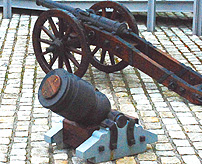 The
Battlefield site is open all year round, daily March and April from
9:30 to 5pm,
May to September 10am to 6pm and October to February
9am to 5pm. Last admission to the visitor’s center is one hour
before closing. Admission to the visitor center is €4 for adults, €3
for Seniors and groups, €2 for Students and Children with a family
ticket for €10. The park and trail walks are free. With a car,
a visit to the Battle of the Boyne site can be combined with the Newgrange
Neolithic site (see Bru
Na Boinne Touring) and the ancient Hill of Tara monument
(see Hill
of Tara)
which is nearby, or Trim Castle, about 15 minutes (see Trim
Castle).
Without a car, day excursion bus tours of these sites can be readily
taken
from
Dublin. © Bargain
Travel Europe
The
Battlefield site is open all year round, daily March and April from
9:30 to 5pm,
May to September 10am to 6pm and October to February
9am to 5pm. Last admission to the visitor’s center is one hour
before closing. Admission to the visitor center is €4 for adults, €3
for Seniors and groups, €2 for Students and Children with a family
ticket for €10. The park and trail walks are free. With a car,
a visit to the Battle of the Boyne site can be combined with the Newgrange
Neolithic site (see Bru
Na Boinne Touring) and the ancient Hill of Tara monument
(see Hill
of Tara)
which is nearby, or Trim Castle, about 15 minutes (see Trim
Castle).
Without a car, day excursion bus tours of these sites can be readily
taken
from
Dublin. © Bargain
Travel Europe
Find best travel deals in County Meath on TripAdvisor
Read Review of Battle of The Boyne Visitor Centre
Web
Info
Battle of
the Boyne
These articles are copyrighted and the sole property of Bargain Travel Europe and WLPV, LLC. and may not be copied or reprinted without permission.
SEE ALSO:
PADDYWAGON - ST PATRICK’S DAY TOURS

